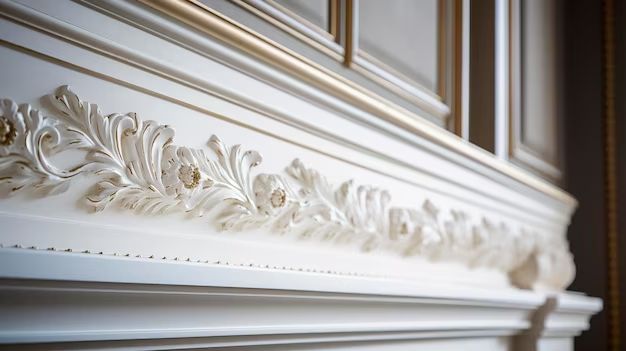Crown moulding and crown molding are terms used to describe decorative trim installed where a wall meets the ceiling. While they sound nearly identical, there are some subtle differences between the two.
Page Contents
The Main Differences
The main differences between crown moulding and crown molding come down to spelling and location:
- Spelling – Crown moulding uses the British spelling with a “u”, while crown molding is the American spelling without the “u”.
- Location – Crown moulding is more commonly used in the UK and Europe. Crown molding is more common in the US and Canada.
However, in everyday usage, the two terms are often used interchangeably, even among professional contractors and interior designers.
Etymology and Origins
Crown moulding and molding take their names from the fact that they are installed where the wall meets the ceiling, forming a “crown” at the top of walls. The origins of the trim style can be traced back centuries:
- Middle Ages – Elaborate crown moldings were used in medieval Gothic architecture as far back as the 12th century.
- Classical Architecture – Crown moldings became more elaborate in the 17th and 18th centuries with Greek and Roman revival styles.
- Victorian Era – Intricate crown moldings reached peak popularity in the Victorian era of the mid-late 1800s.
The specific spelling as “moulding” came from British English. In American English, the word was shortened to “molding” over time.
Similarities Between Crown Moulding and Crown Molding
Despite the minor spelling and usage differences, crown moulding and crown molding share many similarities:
- Purpose – Both serve the same decorative purpose to add architectural detail.
- Materials – Can be made from various materials like wood, plaster, or foam.
- Shapes – Come in a wide variety of ornamental shapes and profiles.
- Installation – Are installed in the same manner, nailed or glued where the wall meets the ceiling.
- Function – Provide a smooth visual transition between vertical and horizontal surfaces.
Popular Profiles and Shapes
Some of the most common crown moulding and molding profiles include:
| Profile | Description |
|---|---|
| Ogee | S-shaped curved profile, concave above, convex below |
| Dentil | Tooth or block like patterns |
| Bevel | Angled flat sloping profile |
| Step | Stepped pattern with 2 or more flat levels |
| Crosshead | Intersecting profile resembling a cross |
In addition to these standard profiles, custom moldings can be created to match architectural themes or ornamental styles.
Advantages of Crown Moulding and Molding
There are several benefits to installing crown moulding or molding in a home or building:
- Aesthetics – Adds stylish decorative appeal and accentuates architecture.
- Finishing Touch – Provides a finished look, especially in formal spaces.
- Increased Value – Can increase a home’s resale value and make rooms appear larger.
- Conceals Flaws – Hides uneven transitions between walls and ceilings.
- Versatility – Comes in a wide range of materials, shapes, and sizes.
- Protection – Protects corners and transitions from damage.
Disadvantages of Crown Moulding and Molding
Potential downsides to crown mouldings include:
- Cost – Can be more expensive than some other trim options.
- Installation – Is harder to install than simpler trim, often requiring special tools.
- Maintenance – Needs occasional repainting or refinishing over time.
- Accumulated Dust – Ornate profiles can collect dust and require frequent cleaning.
- Limitations – May be difficult to install properly in rooms with awkward layouts or low ceilings.
Installation Tips
Proper installation is key to getting high quality results from crown mouldings. Useful installation tips include:
- Careful measurement – Precisely measure corners and angles to cut pieces accurately.
- Miter cuts – Ends should be cut at 45° angles to create neat seams where pieces join.
- Pre-finishing – Sand and pre-finish pieces before installing for easier finishing.
- Nail placement – Nails should be discretely placed and filled to hide visible holes.
- Glue reinforcement – Use construction adhesive as well as nails for a stronger bond.
- Level execution – Check for level frequently to avoid wavy or uneven results.
- Paint touch ups – Use painter’s caulk and touch up paint to hide imperfections.
Costs
The cost to install crown moulding or molding depends on several factors:
- Material – Wood, foam, or plaster. Wood is generally the most expensive option.
- Complexity – Simple flat trim vs elaborate hand-carved details.
- Amount needed – Total linear feet based on room size.
- Height – Standard heights around 9 inches cost less than taller 12 inch moldings.
- Labor – Hiring a professional vs doing it yourself.
- Accessibility – Ease of access to install and finish the work.
On average, expect to pay:
- DIY Materials – $2 to $8 per linear foot for materials.
- Professional Install – $6 to $15 per linear foot for installation.
For a 10×12 foot dining room, that could mean a total cost of $500 to $1800+ for an professionally installed natural wood crown molding.
Conclusion
While the terms crown moulding and crown molding have minor distinctions in spelling and geographic usage, they effectively serve the same purpose as decorative trim where walls meet ceilings. The options for shapes, styles, and materials are endless when adding this architectural detail. With attention paid to proper installation and finishing, crown moldings can add beauty and value to all types of indoor spaces and rooms. Thinking of installing this decorative accent? Now you know the key differences, similarities, costs, and tips for success with crown moulding versus molding.
